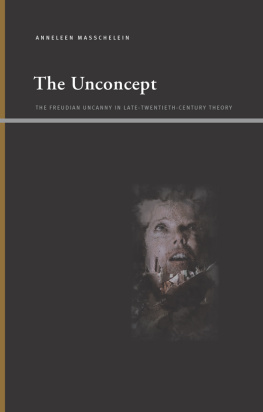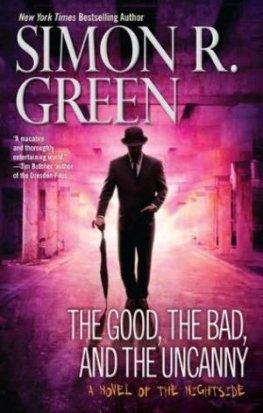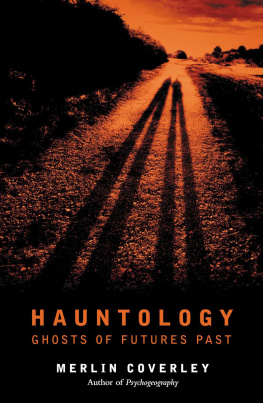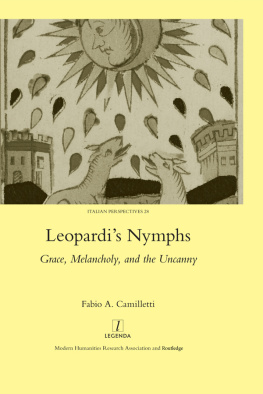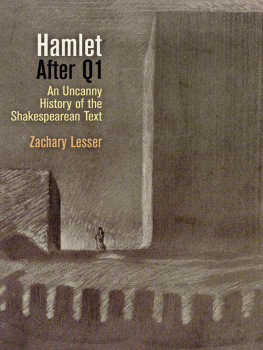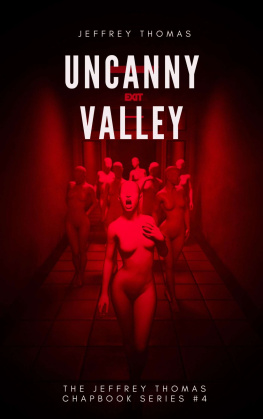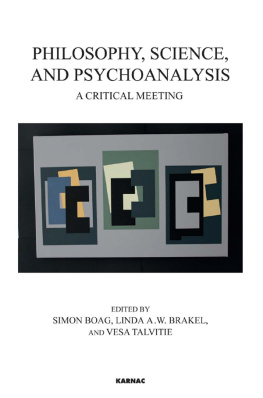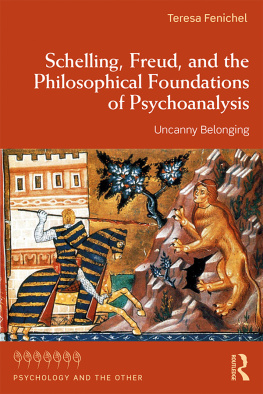SUNY series, Insinuations: Philosophy, Psychoanalysis, Literature

Charles Shepherdson, editor
The Unconcept
The Freudian Uncanny in
Late-Twentieth-Century Theory
Anneleen Masschelein

Published by State University of New York Press, Albany
2011 State University of New York
All rights reserved
Printed in the United States of America
No part of this book may be used or reproduced in any manner whatsoever without written permission. No part of this book may be stored in a retrieval system or transmitted in any form or by any means including electronic, electrostatic, magnetic tape, mechanical, photocopying, recording, or otherwise without the prior permission in writing of the publisher.
For information, contact State University of New York Press, Albany, NY
www.sunypress.edu
Production by Diane Ganeles
Marketing by Anne M. Valentine
Library of Congress Cataloging-in-Publication Data
Masschelein, Anneleen, 1971
The unconcept : the Freudian uncanny in late-twentieth-century theory /
Anneleen Masschelein.
p. cm. (SUNY series, Insinuations)
Includes bibliographical references (p.) and index.
ISBN 978-1-4384-3553-4 (hardcover : alk. paper)
1. Aesthetics, Modern20th century. 2. Uncanny, The (Psychoanalysis) 3. Fantastic, The. I. Title.
BH301.F3M37 2011
154.2dc22 2010032050
10 9 8 7 6 5 4 3 2 1
This book has become a permanent reminder
of my brother Wouter, who is missed every day.
This book is dedicated to him and to my parents,
Lieve and Raf Masschelein, who have been
an inspiration throughout.
Preface
The present book is the result of a longstanding research project that began in 1994. In 2002, the preface of my PhD began with a few lines from W. H. Auden's This Lunar Beauty:
But this was never
A ghost's endeavour
Nor, finished this,
Was ghost at ease
These prophetic words announced an ongoing process of thinking about the uncanny that finally presents itself as a slim volume compared to the PhD text.
Over the years, the uncanny has continued to flourish, to meander, and to be criticized. Steeped in new research projects and teaching, I always kept one eye open for the new forms and journeys of the concept. At the same time, I strove to really capture the dynamic core of its specific conceptualization process as precisely as possible, in the hope of offering some new insights in what may seem to be familiar territories. I would first and foremost like to thank the editors at SUNY Press, Charles Shepherdson, Jane Bunker, and Andrew Kenyon, for believing in this project and for giving me the opportunity to put the uncanny to rest (if such a thing were possible ). I also want to thank Diane Ganeles and Anne M. Valentine for their help with the production of this book. In the course of my research, many people have been invaluable to my work. My heartfelt thanks to Dirk de Geest and Hendrik Van Gorp, who introduced me to literary theory, the gothic, and psychoanalysis, and also to writing and to academic life with great wisdom and wit. The first readers of this work, Jan Baetens, Sjef Houppermans, and Nicholas Royle, have continued to help me throughout the years: I would not be where I am today without their support. For the past four years, the National Research Fund of Flanders (FWO Vlaanderen) helped me finish the book by giving me time for research. Several readers have provided their generous and astute comments on versions of the book: the readers at SUNY press, Karl-Heinz Barck at the Zentrum fr Literatur und Kulturforschung, Joost de Bloois, Ortwin de Graef, Maarten de Pourcq, Arne de Winde, Edward Kazarian, Andrew McNamara, Paul Moyaert, Jean-Michel Rabat, and Eveline Vanfraussen. Carol Richards did a wonderful job editing this book. I found stimulating intellectual platforms at the Cornell Summer School of Theory and Criticism (2003), especially with Mary Jacobus and Pamela Goodacre Brown; at the University of Pennsylvania (2005) where I was warmly welcomed by Liliane Weissberg; at the Sign of the Times-conference in Leuven (2008); and at the Institute of the Uncanny, a mysterious subdividision of the Institute of Cultural Inquiry in Berlin (2009). Teaching in Leuven and in Amsterdam has been a great source of inspiration. My colleagues at Leuven, Koen Geldof, Rita Ghesquiere, Mia Hamels, Marijke Malfroidt, Nicolas Standaert, and Laurence Van Nuijs have helped me in various ways. I also want to thank Nicolas Provost for the image on the cover of this book. My family and friends have been invaluable and steady companions throughout the years.
Michal and Elliot: there are no words for what you mean to me. Life is so much better since you both arrived.
Introduction
Imperfection is, paradoxically, a guarantee for survival.
()
1.1. A Genealogy of the Uncanny
In 1965, professor Siegbert S. Prawer concluded his inaugural lecture at Westfield College, London entitled The Uncanny in Literature. An Apology for its Investigation, with the following words.
I hope to have demonstrated this evening that for all the dangers which attend a too exclusive preoccupation with it, for all the crude and melodramatic and morally questionable forms in which it so often confronts us, the uncanny in literature does speak of something true and important, and that its investigation, therefore is worth our while. ()
This cautious plea, uttered almost half a century ago, reminds us of how fast things change in a relatively brief period of time. Nowadays, the topic of the uncanny no longer begs for an apology. On the contrary, it is an accepted and popular concept in various disciplines of the humanities, ranging from literature and the arts, to philosophy, film studies, theory of architecture and sociology, and recently even crossing over to the hard field of robotics and artificial intelligence.
In the most basic definition, proposed by Sigmund Freud in 1919, the uncanny is the feeling of unease that arises when something familiar suddenly becomes strange and unfamiliar.). Royle's understanding of the term places him in a tradition of uncanny thinking, to paraphrase Samuel Weber, most commonly associated with the works of Jacques Derrida, Sarah Kofman, Hlne Cixous, Jean-Michel Rey, Weber, Neil Hertz, Anthony Vidler, Elizabeth Wright, and Julian Wolfreys, to name but a few authors who extensively wrote on the uncanny.
As we will see, this type of thinking fundamentally questions and destabilizes the status and possibility of concepts and the uncanny has become a concept that signals this questioning. However, the present study also shows that this is but one side of the coin. The consequence of Royle's conception of the uncanny as a strategy and attitude of perpetual defamiliarization, deconstruction or hauntology is that the teaching practice he envisions and practices is highly individualistic and creative. The fact that Prawer's apology is not listed in Royle's impressive bibliography cannot be considered as a flaw: Royle's book does not want to offer a systematic history of the uncanny, even if it accumulates a wealth of information, especially about the development of the uncanny in the last decades of the twentieth century. Moreover, it is unlikely that the name Prawer will ring a bell among contemporary scholars working on or interested in the uncanny, even if his extensive work on the uncanny was in many ways ahead of its time. His words remind us that the rise of the concept in different disciplines of the humanities is not a tale of straightforward ascent to conceptual clarity and complexity.

